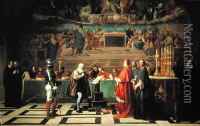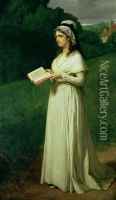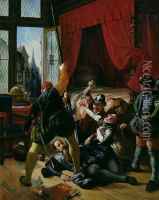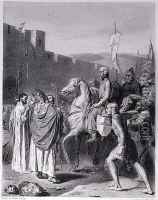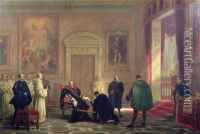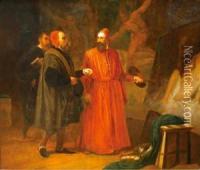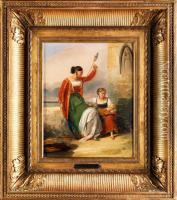Joseph-Nicolas Robert-Fleury Paintings
Joseph-Nicolas Robert-Fleury was a distinguished French painter born in Cologne, Germany, in 1797. He was part of the 19th-century French academic painting tradition, known for his historical and grand genre scenes. Robert-Fleury made significant contributions to the art world during his time, with a career that spanned much of the 19th century, reflecting the sensibilities and historical interests of his era.
Robert-Fleury's education in art began under the tutelage of his father, who was also an artist. He further honed his skills at the prestigious École des Beaux-Arts in Paris, where he studied under the guidance of renowned painters such as Antoine-Jean Gros. This foundational education set the stage for Robert-Fleury's development as a painter, deeply influencing his style and thematic preferences.
Throughout his career, Robert-Fleury was celebrated for his ability to bring historical events and figures to life on canvas. One of his most famous works, 'Galileo before the Holy Office', showcases his mastery in depicting historical scenes with emotional depth and technical precision. This painting, among others, illustrates his focus on dramatic moments in history, characterized by detailed compositions and a keen sense of storytelling.
In addition to his painting career, Robert-Fleury played a significant role in the French art community as a teacher. He taught at the École des Beaux-Arts, where he influenced a generation of artists, including some who would go on to define the next era of French painting. His impact as an educator extended beyond the confines of the school, as he was actively involved in various artistic committees and associations, contributing to the development of art policies and education in France.
Joseph-Nicolas Robert-Fleury's legacy is marked by his contributions to the historical painting genre and his influence on the artists he taught. His works remain a testament to his skill in capturing the essence of historical narratives, earning him a place among the notable painters of the 19th-century French academic tradition. He passed away in 1890, leaving behind a body of work that continues to be celebrated for its historical significance and artistic merit.
